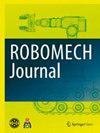A robotic end-effector with rolling up mechanism for pick-and-release of a cotton sheet
IF 1.7
Q3 INSTRUMENTS & INSTRUMENTATION
引用次数: 2
Abstract
In this paper we introduce a novel robotic end-effector for pick-and-release of a sheet of cotton cloth. One of the main operations in a factory for sewing cloth products is to pick up cloth parts, provide them to a sewing machine, and sew them together. Fabric products are assembled by performing this work in various processes. Each work starts with a lot of cloth parts stacked near a sewing machine. In the case of underwear, thin cotton cloth is the target of manipulation, but such cloth parts tend to stick to each other, and a certain skill or technical acuity is required for picking up. Therefore, this work is basically done manually in the present. The purpose of this study is to automate such manipulation, so we devise an end-effector that picks up only the top one of stacked cotton sheets. The proposed end-effector has a mechanism that is a cylindrical brush attached with a remover cloth on its surface. The cylindrical brush is grounded on a cotton sheet, and then is rotated to roll up only the cotton sheet. This mechanism makes it possible to release the sheet by rotating the brush in the reverse. We constructed hardware with this function and attached it to the tip of a robotic manipulator. In addition, we performed system integration so that the initial position of rolling up a cotton sheet could be automatically determined from images taken by a camera. We also conducted evaluation experiments.一种带有卷起机构的末端执行器,用于收放棉片
本文介绍了一种新型的棉布拾取和释放机器人末端执行器。缝制布料产品的工厂的主要操作之一是挑选布料零件,将它们提供给缝纫机,并将它们缝制在一起。织物产品是通过在不同的过程中完成这项工作而组装起来的。每一项工作都是在缝纫机附近堆放许多布料零件开始的。以内衣为例,薄棉布是操作的对象,但这样的布质部位容易相互粘住,拿起需要一定的技巧或技术敏锐度。因此,目前这项工作基本上是手工完成的。本研究的目的是使这种操作自动化,因此我们设计了一种末端执行器,它只拾取堆叠的棉片的顶部。所提出的末端执行器具有一种机构,该机构是附着在其表面上的去除布的圆柱形刷。圆柱形刷在棉片上接地,然后旋转,只卷起棉片。这种机制可以通过反向旋转刷来释放薄片。我们用这个函数构造了硬件,并将其连接到机器人的末端。此外,我们进行了系统集成,使卷棉片的初始位置可以由相机拍摄的图像自动确定。我们还进行了评价实验。
本文章由计算机程序翻译,如有差异,请以英文原文为准。
求助全文
约1分钟内获得全文
求助全文
来源期刊

ROBOMECH Journal
Mathematics-Control and Optimization
CiteScore
3.20
自引率
7.10%
发文量
21
审稿时长
13 weeks
期刊介绍:
ROBOMECH Journal focuses on advanced technologies and practical applications in the field of Robotics and Mechatronics. This field is driven by the steadily growing research, development and consumer demand for robots and systems. Advanced robots have been working in medical and hazardous environments, such as space and the deep sea as well as in the manufacturing environment. The scope of the journal includes but is not limited to: 1. Modeling and design 2. System integration 3. Actuators and sensors 4. Intelligent control 5. Artificial intelligence 6. Machine learning 7. Robotics 8. Manufacturing 9. Motion control 10. Vibration and noise control 11. Micro/nano devices and optoelectronics systems 12. Automotive systems 13. Applications for extreme and/or hazardous environments 14. Other applications
 求助内容:
求助内容: 应助结果提醒方式:
应助结果提醒方式:


